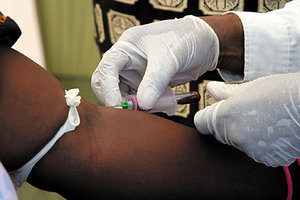Up until the turn of the century, vitamin D did not get a great deal of attention compared to other vitamins.
A new study has shed light why so many African-Americans have low vitamin D. Blacks with low laboratory values of vitamin D on the standard blood tests may not be low in vitamin D at all.1 It turns out that many African-Americans have lower amounts of the protein that carries 25(OH)D in their blood. In other words, unlike lighter skinned people without African genetics, lower amounts of inactive vitamin D in their blood does not correlate with their overall vitamin D status.
Research is ongoing to determine how blacks compensate for lower 25(OH)D in the blood. In the meantime, unlike a light-skinned person, a dark-skinned person with low vitamin D on a blood test must have clinical correlation such as low bone density, low dietary intake, low sun exposure, lipid-lowering medication and/or symptoms of low vitamin D (muscle, bone and joint pain, fatigue, malaise, fractures)
 Vitamin D is made from cholesterol and sun exposure. Vitamin D can also come from food. The top source is fortified milk. Cod liver oil, swordfish and salmon contain more vitamin D per serving, but for most people they are not everyday foods. Meanwhile, per-capita milk consumption has been decreasing for at least three decades, and the most prescribed drug in America (with almost 24 million prescriptions a year) lowers cholesterol.
Vitamin D is made from cholesterol and sun exposure. Vitamin D can also come from food. The top source is fortified milk. Cod liver oil, swordfish and salmon contain more vitamin D per serving, but for most people they are not everyday foods. Meanwhile, per-capita milk consumption has been decreasing for at least three decades, and the most prescribed drug in America (with almost 24 million prescriptions a year) lowers cholesterol.
Sun exposure is also on the decline, and people with very dark skin genetically adapted to spend long periods outdoors in the sun have been spending their time indoors. Darker-skinned people can require 5-6 times as much sun to make the same levels of vitamin D as a person with very light skin. (My rule of thumb is the that the average black skin tone will need three times as much sun as the average white skin tone to make equal amounts of vitamin D if sunscreen is not used.)
The form of vitamin D we measure in standard testing is called 25-hydroxyvitamin D [(25(OH)D)]. It is biologically inactive, but is far better indicator of vitamin D status than the active form, which is 1,25-dihydroxyvitamin D [(1,25(OH)2D)]. This is because 1,25(OH)2D will still have normal levels in the blood, even when a person is low in vitamin D.
Reference
- Powe CE, Evans MK, Wenger, J, et al. Vitamin D–binding protein and vitamin D status of black Americans and white Americans. N Engl J Med, 2013;369:1991-2000.
Click here for previous articles by G. Douglas Andersen, DC, DACBSP, CCN.





